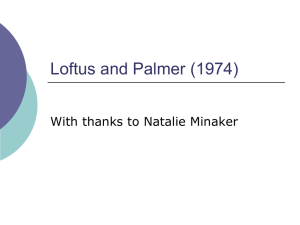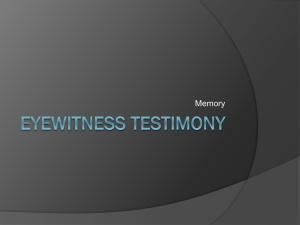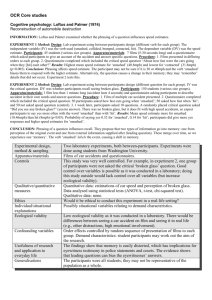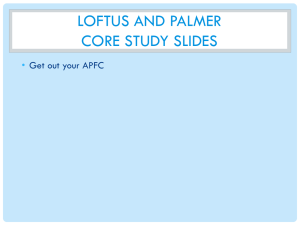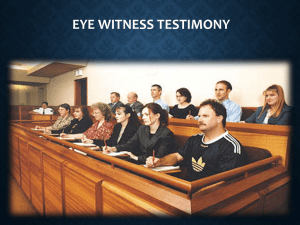DOC Loftus and Palmer summary
advertisement
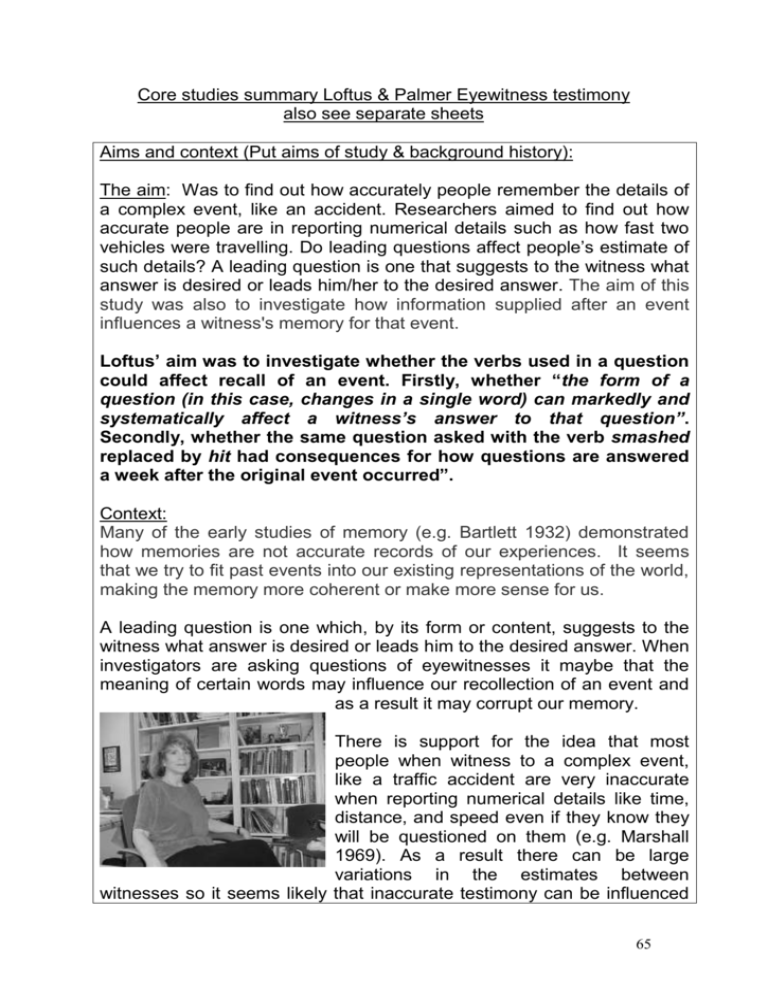
Core studies summary Loftus & Palmer Eyewitness testimony also see separate sheets Aims and context (Put aims of study & background history): The aim: Was to find out how accurately people remember the details of a complex event, like an accident. Researchers aimed to find out how accurate people are in reporting numerical details such as how fast two vehicles were travelling. Do leading questions affect people’s estimate of such details? A leading question is one that suggests to the witness what answer is desired or leads him/her to the desired answer. The aim of this study was also to investigate how information supplied after an event influences a witness's memory for that event. Loftus’ aim was to investigate whether the verbs used in a question could affect recall of an event. Firstly, whether “the form of a question (in this case, changes in a single word) can markedly and systematically affect a witness’s answer to that question”. Secondly, whether the same question asked with the verb smashed replaced by hit had consequences for how questions are answered a week after the original event occurred”. Context: Many of the early studies of memory (e.g. Bartlett 1932) demonstrated how memories are not accurate records of our experiences. It seems that we try to fit past events into our existing representations of the world, making the memory more coherent or make more sense for us. A leading question is one which, by its form or content, suggests to the witness what answer is desired or leads him to the desired answer. When investigators are asking questions of eyewitnesses it maybe that the meaning of certain words may influence our recollection of an event and as a result it may corrupt our memory. There is support for the idea that most people when witness to a complex event, like a traffic accident are very inaccurate when reporting numerical details like time, distance, and speed even if they know they will be questioned on them (e.g. Marshall 1969). As a result there can be large variations in the estimates between witnesses so it seems likely that inaccurate testimony can be influenced 65 by such variables like leading questions. Marshall did a study where Air Force personnel were questioned about the speed of a moving car. They knew in advance they would be asked this and worryingly estimates ranged from 10-50 mph; the car they watched was only going at 12 mph. Psychologists like Loftus & Palmer are interested in eye-witness testimony, as juries are convinced by eye-witness accounts and will tend to return guilty verdicts when there has been an eyewitness account presented by the prosecution. Even when the eye-witness has been discredited juries are still convinced by the information. Psychological research into memory strongly suggests that there are many factors which would make eye-witnesses unreliable and the Devlin Committee (1973) recommended that juries should be instructed that it is not safe to convict on the basis of eye-witness testimony alone. Eyewitness testimony is unreliable. Eyewitness memory can be mistaken due to the things that go wrong at the time of the event itself e.g. poor lighting or extremely high stress or fright. Memory can be wrong due to things that go wrong after the event is over. For example, one witness can be exposed to the mistaken recollection of another witness, or the witness is questioned in a biased way or the test of memory is unfair in some way and leads the witness to say the wrong thing. Filmore (1971) suggests that the words smashed and hit may involve differential rates of movement. They also lead the listener to assume different consequences to the impacts to which they are referring, with hit being perceived as gentler than smashed. Procedures (What did the Psychologists do to the participants?) Experiment 1: 45 students participated in smaller groups of various sizes. They were shown safety films of traffic accidents lasting 5-30 seconds. After each film they had to fill in a questionnaire about what they had seen. 66 They then answered questions about the accident; the critical question was the one that asked the participants about the speed of the vehicles involved in the accident. 9 participants (p’s) were asked “About how fast were the cars going when they hit each other?” Equal numbers of the remaining p’s were asked the same question but with the verb changed, so some groups were asked the question changed to smashed, collided, bumped, and contacted instead of hit. Participant estimates of speed in each group were recorded in miles per hour. Experiment 2: 150 p’s took part in groups of various sizes. A film showing a multiple car accident was presented. P’s had a questionnaire where they first had to describe what went on in the film of 1 minute. They then had to answer questions about the accident. The critical question asked 50 p’s “About how fast were the cars going when they smashed into each other?” Another 50 p’s were asked the same question but with the word hit supplied instead of smashed. The final 50 participants were a ‘control’ group and were not exposed to any question. 1 week later p’s returned and were asked a series of questions about the film they saw the week before. The critical question was “Did you seen any broken glass?” they had to tick off YES or NO. This question appeared in a random position with 9 other questions - there was no broken glass in the accident. 67 Perspective : cognitive Method: Lab experiment 3 advantages of the methodology: Sample (e.g. representative) Internal & external validity/internal & external reliability/ethics & any other issues: 1. A well controlled and operationalised experiment. Age of the participants, location of study, and use of video (length of films) were all controlled. 2. The experimental method is reliable as procedures can be replicated and if the same results are found over time we have confidence in the findings. Later studies have found similar findings e.g. Loftus & Zanni (1975) found leading questions affect recall. More people answered ’yes’ to the question “Did you see THE broken headlight” as opposed to “Did you see A broken headlight?” 3. The information the p’s were asked to recall was meaningful & would be likely to occur in real life so results are representative of the demands of our everyday memory, so findings could be generalised to real life. 4. Cause and effect relationship can be established between IV and DV as the variables are all controlled (e.g. See 1 above) No other research method can do this directly. 3 disadvantages of this methodology: Sample bias/validity – internal & external/reliability internal & external/ethics/gender bias/cultural bias & any other issues: 1. Students were used in each part of the study, students may not be representative of the general population and it is hard to generalise results from this study to other types of people. 2. The experiment was based in a laboratory which is an artificial environment; the students may have reacted to demand characteristics - clues in the study for how to behave. This would produce invalid results. It could also lack internal validity because of demand characteristics. 3. Ethics - the p’s were deceived about the purpose of the experiment. 68 This also means they had no informed consent and didn’t know aims of the study. 4. Research lacks mundane realism (task in the study is not like real life task/event) as there are differences between observing an event like a car crash in real life and observing one on a TV. screen, if we actually witness a car crash we are emotionally affected by it, this could affect your memory in a different way from the film shown by Loftus & Palmer. Findings and conclusions of the study: Experiment 1: P’s were not very good at estimating the speed of a vehicle. Estimates of the speed of the vehicle averaged 40.8mph if the p’s heard the words smashed, 39.3 if the p’s heard the word collided in the first experiment and so on. If they heard contacted, the estimate was only 31.8 mph. Participants estimated that the vehicles had been travelling fastest when the verb ‘smashed’ was used. Participants estimated that the vehicles had been travelling slowest when the verb ‘contacted’ was used. Conclusions experiment 1: These findings indicate that the form of a question (in this case, changes in a single word) can markedly and systematically affect a witness’s answer to that question. Experiment 2: Even though there was no broken glass in the film, 16 out of 50 p’s from the smashed condition said they remember seeing broken glass! 7 out of 50 in the hit condition stated they had seen broken glass and 6 out of 50 in the control group (not asked a question on speed). When the verb ‘smashed’ was used, participants were over twice as likely to report seeing broken glass than when the word ‘hit’ was used and compared to the control condition. 69 Conclusion: - Leading questions (in this case a single word) can distort a witness’s memory for an event. Conclusion: - This seemingly small change had consequences for how questions are answered a week after the original event occurred. Conclusion: - People’s accuracy for reporting the details of a complex event is potentially distorted through the use of leading questions. Conclusions overall: The way a question is asked can affect the response enormously. When we witness an event we have the information at that time of the original event, i.e. our perception of that event, then we have extra information supplied to us after the event, in this case the words (smashed etc). Over time information from these two sources are integrated and mixed up together, and we have one new memory. The participant who heard the word “smashed” has a memory of the accident being more severe than it was. As broken glass is often seen at a severe accident the participant is more likely to believe that glass was present. The questions asked can be termed 'leading' questions because they affected the participants' memory of the event. The question contained information about what the answer should be. Therefore, this language can have a distorting effect on eyewitness testimony, which can lead to inaccurate accounts. It is possible that the original memory has been reconstructed, but it is impossible to conclude that the original memory may have been replaced or experienced interference. Alternative and complementary research findings: Complementary: Loftus (1975) showed 150 p’s a film showing a car accident, after the showing p’s were divided into 2 groups & each group was asked 10 questions about what they had seen. Group 1 were asked questions which matched the film they saw e.g. “How fast was the white sports car going when it passed the ‘stop’ sign?” Group 2 was given all the same questions except for one which was “How fast was the white sports car going when it passed the barn when travelling on the country road?” This question was misleading as there was no barn in the film. After a week, 70 the p’s were all asked another 10 questions the final question was “Did you see a barn?” many more in group 2 said they had seen a barn (17.3% as opposed to 2.7% in group 1). In group 2 the barn information had been added to the original memory at the question stage so now it became part of the original memory. Loftus & Zanni study (see previous). Bartlett (1932) found in a study that when people are given a story which is unfamiliar to the participants, their memory is inaccurate and the memory is changed continually over time, participants missed out information from the story and changed the order of events. This agrees with Loftus as it shows how fragile memory is and how it can be reconstructed to fit in with the participant’s cultural knowledge. Alternative findings: Christianson & Hubinette (1993) questioned 110 witnesses who saw between them 22 genuine bank robberies. Some of these p’s were onlookers at the bank at the time, others were bank employees who had been directly threatened. Victims were more accurate in their memory and remembered what the robbers wore, their behaviour and the weapon used than the bystanders. People are better at remembering very stressful events if they occur in real life rather than the laboratory. Foster et al (1994) believed that p’s in experiments are less accurate in memory for events than in real life as if they are wrong there will be less serious consequences. Foster showed p’s a video of a bank robbery & asked them to identify the robber in the parade. One group were misled to believe the robbery was a real event and their responses would influence the trial, the other group assumed it was not a real life event. Identification of the robber was more accurate for the first group suggesting the consequences of identifying someone as guilty or not is an important factor for witnesses. Loftus (1979) showed p’s a set of slides that showed the theft of a large red purse from a handbag, they were later read a version of what happened which said the purse was brown; all but 2 participants correctly remembered that the purse was in fact red. This shows that people are not misled by information that is obviously incorrect. Evaluation points of the study: 71 Strengths: The research supports the idea that memory can be easily distorted and has implications for eyewitness testimony in court. You can tell cause and effect, as it is a lab experiment e.g. IV = verb used, this affects the DV = speed estimate. Quantitative data gathered, useful to make clear comparisons between groups and allow for statistical analysis. Practical applications - the fact that leading questions can affect memory has important implications for interviewing witnesses by police straight after the event and also lawyers in court some time after. Interviewers should avoid leading questions and be careful in how they word questions. Weaknesses: There will always be individual differences where not everyone’s memory will be inaccurate and Loftus doesn’t take this into account. Reductionist - reducing human memory to a simple explanation whilst ignoring cultural factors and emotion, e.g. how that affects memory, mood etc. Ethnocentric - American group of students are used as a basis to make conclusions about human memory in all cultural groups. Hawthorne effect - people may change their behaviour as they know they are in an experiment so results may not be valid, what they state etc. Psychology as a science - Psychology should not just be seen as objective and scientific this is only one of many frameworks the researchers work in here; there are other more subjective methods to study human behaviour like memory, such as participant observation in a group and unstructured interviewing where more valid responses may be given in a more informal situation. 72 73
